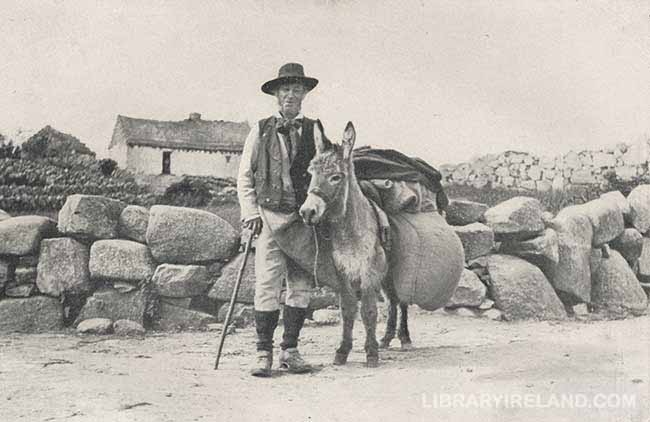The Claddagh, Galway
The Bay of Galway consists of a long arm of the sea, protected at the entrance by the lofty cliffs of the islands of Aran, which in clear weather are visible at a distance of twenty-nine miles, and on the north and south by the coasts of Galway and Clare, respectively. A legend in the annals of Ireland states that it was once a fresh-water lake known as Lough Lurgan, one of the three principal lakes in Ireland, and was converted into a bay by the Atlantic breaking over and uniting with the water therein.

A Connemara Tinker
A large number of the population is employed in the salmon and herring fishery, and the Claddagh is their home. This is an extraordinary assemblage of low, thatched cottages, built with total disregard to system, and numbered indiscriminately. Hardiman wrote of them as follows: "The colony from time immemorial has been ruled by one of their own body, periodically elected, who is dignified with the title of mayor, regulates the community according to their own peculiar laws and customs, and settles all their fishery disputes. His decisions are so decisive and so much respected that the parties are seldom known to carry their differences before a legal tribunal or to trouble the civil magistrates." The title and office are now quite obsolete. At one time they never allowed strangers to reside within their precincts, and always intermarried among themselves, but now strangers settle among them. They are a very moral and religious people; they would not go to sea or away from home on any Sunday or holiday. The dress of the women of the Claddagh was formerly very peculiar, and imparted a singular foreign aspect to the Galway streets and quays. It consisted of a blue mantle, red body-gown and petticoat, a handkerchief bound round the head, and legs and feet au naturel; but that dress is rarely seen now. The Claddagh ring—two hands holding a heart—becomes an heirloom in a family, and is handed down from mother to daughter.
One of the sights of the town is to see the salmon waiting to go up the Galway River to spawn. We rose one morning quite early to see this, when the fish would not be disturbed, and we watched them from the bridge for an hour. It was worth the effort; we saw them packed in schools, quivering and jostling one another in their eagerness to get up to the spawning-grounds.
At our hotel we found an interesting character who served in the capacity of waiter. When questioned on the subject of his past life, he said that he had come from Hamburg when twenty years old. He spoke German broken into English with a strong Connemara brogue; and if Weber and Fields could only have heard him describe the items on a carte de jour, he would not be left long in Galway, but would find his opportunity in their dramatic temple on Broadway.
Read "On an Irish Jaunting Car through Donegal and Connemara" at your leisure
Read On an Irish jaunting Car through Donegal and Connemara at your leisure and help support this free Irish library.
Samuel Gamble Bayne was born in Ramelton, County Donegal, and educated at Queen's University in Belfast. At the age of twenty-five he left for America with a view to making his fortune. He invested in an oil well in Pennsylvania and later founded a bank which subsequently came to be the JP Morgan Chase bank in New York. By the time this book was written he was wealthy enough to be referred to as a billionaire. His account of the tour through the north, west and south of Ireland is a pleasant snapshot of how that part of the country was in the early part of the 20th century. He describes what is to be seen, gives some background history and, through the illustrations especially, provides wonderful glimpses of the area's social history.
The ebook is available in .mobi, .epub, and .pdf formats. See details ».

